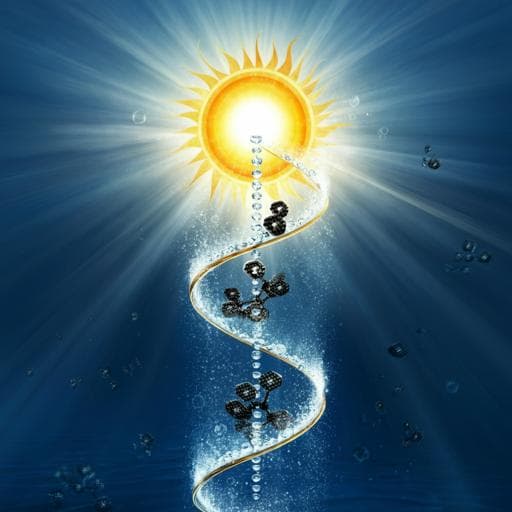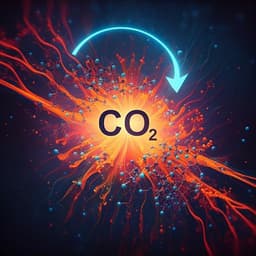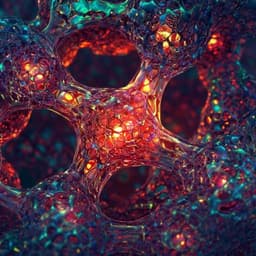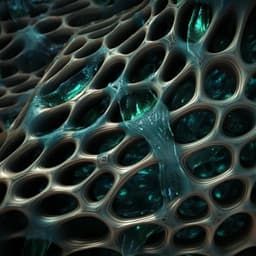
Engineering and Technology
Scalable and high throughput photothermal water disinfection with negligible CO₂ footprint utilizing nanostructured carbon coatings
A. Sah, A. K. Mandal, et al.
Discover the groundbreaking research by Ananya Sah and colleagues on nanostructured porous hard-carbon florets as a revolutionary solar absorber coating for photothermal water disinfection. This innovative approach achieves high water temperatures for effective disinfection while maintaining a low CO₂ footprint, offering a sustainable solution for clean water access.
~3 min • Beginner • English
Introduction
The study addresses the global need for clean water and reduced CO₂ emissions from conventional water heating and disinfection. Microbial contamination is a major cause of water-borne illness, and boiling is the standard disinfection method but relies heavily on fossil fuels, contributing significantly to greenhouse gas emissions. Solar energy offers a sustainable heat source, yet traditional solar-thermal systems suffer from inefficiencies, complex multi-layer coatings, vacuum cladding requirements, degradation in humid environments, and limited throughput. Optical UV-based disinfection is electricity-dependent, less effective in turbid water, and can induce harmful byproducts from plastics; chlorination risks regrowth and carcinogenic byproducts. The research question is whether a scalable, broadband, durable solar-thermal absorber coating can deliver high-efficiency water heating and robust, non-contact thermal disinfection with low CO₂ footprint and high throughput, even for turbid and highly contaminated water. The authors propose nanostructured carbon florets (NCF) as a near-blackbody, high ηSTC coating on tapered helical aluminum receivers to generate sufficient heat for continuous-flow disinfection while overcoming biofouling and contamination issues.
Literature Review
- Conventional solar-thermal coatings (e.g., black nickel, black chromium, metal/metal oxide stacks) provide selective absorption, require multi-layer architectures and vacuum cladding to curb losses, and degrade under humid conditions, lowering efficiency and complicating scalability.
- Solar distillation is ubiquitous but low-throughput (5–7 L m⁻² day⁻¹) and may introduce contaminants (e.g., Cr(VI)); area demands and intermittency limit adoption.
- UV-based water disinfection (200–400 nm) is line-of-sight, suffers in turbid water (>5 NTU) due to attenuation, requires electrical power, and can generate harmful plastic-derived contaminants (e.g., benzene, BPA, fluorinated alkanes, VOCs) via UV-induced degradation.
- Chlorination is scalable and affordable but risks microbial regrowth, prompting excessive dosing and formation of carcinogenic byproducts (THMs, HAAs).
- Contact-based antimicrobial materials (zeolites, polymers, metal/metal-oxide nanoparticles such as Ag, Zn, Cu, Fe) can be effective against Gram-negative and Gram-positive bacteria but require direct contact, suffer biofouling, activity degradation, and require regeneration.
- Prior limitations in achieving materials that are simultaneously broadband-absorbing, low thermal conductivity, and high thermal effusivity have driven reliance on thermal management (vacuum jacketing) rather than material solutions.
- Commercial ETC absorber coatings (e.g., Pyromark, NALSUN) reach ~70% solar-thermal conversion efficiency; higher-efficiency, durable, scalable alternatives could reduce land area or increase throughput by ~25%.
Methodology
Materials synthesis and coating:
- Nanostructured carbon florets (NCF) were synthesized via chemical vapor deposition (CVD) of acetylene (100 sccm) at 740 °C onto dendritic fibrous nanosilica (DFNS) templates, followed by NaOH (1 M) etching of silica to yield porous hard-carbon florets. The product was washed and dried.
- NCF morphology: marigold-like, conical self-assembly with interconnected folded lamellae; porous (BET surface area ~867.5 m² g⁻¹). Hard-carbon character confirmed by Raman (D- and G-bands; D-band dispersion with excitation wavelength), XPS (C1s at 284.0 eV, sp² C=C), pXRD ((002) around 25° with broad FWHM), TGA (complete combustion by 583 °C; no residual SiO₂), FTIR (no Si–O features), HAADF/TEM/SEM (no residual silica, short-range graphitic domains ~0.4 nm). Non-graphitizable upon heating to 1200 °C.
- Coating preparation: NCF dispersed in isopropanol (bath sonication) and spray-coated uniformly (approx. 90 °C substrate) onto the inner region of a hollow aluminum tapered helical coil (length 12 ft; inner diameter 3.8 mm; outer diameter 6 mm; 14 turns; half-cone angle 30°; coil height 9 cm; upper diameter 130 cm, lower diameter 3 cm). Coating thickness 7 ± 2 µm (surface coverage 0.8 mg cm⁻²); adhesion measured at 5.13 MPa. The coil’s non-illuminated outer region was sheathed with silicone sealant to reduce convective/radiative losses.
Experimental setup and operation:
- Solar-thermal experiments conducted under direct solar irradiance of 2000 W m⁻² (“2 sun”), with a glass cover, unless otherwise specified. Thermal imaging via FLIR A6703sc; outlet water temperature via thermocouple.
- Flow-through operation at various flow rates (2, 3, 7, 10 mL min⁻¹). Surface (coil turns) and outlet temperatures monitored over time to assess temperature rise, residence time effects, and maximum differentials (ΔTsur, ΔTout).
- Intermittent-flow mode: cycling between ON (10 mL min⁻¹) and OFF (0 mL min⁻¹) within 10-min cycles to elevate outlet temperatures at higher nominal flow.
Water stability tests:
- Continuous passage of water containing CaCl₂ (2000 ppm Ca²⁺) at 7 mL min⁻¹ for >60 h; monitored TDS, outlet temperature, and performed ICP-AES for Al, Ca²⁺, Cl⁻.
Bacterial disinfection assays:
- Buffered water (PBS, pH 7.2) spiked with Escherichia coli at 10⁴ and 10⁶ CFU mL⁻¹. Counted via standard agar plate method pre- and post-device. Controls: dark (no light), uncoated Al under illumination, and direct sunlight exposure of contaminated water without device.
- Turbid water tests: untreated lake water (Powai lake) filtered through Whatman Grade 1 to remove suspended impurities; turbidity ~5.2 NTU containing lactobacillus (4×10⁵ CFU mL⁻¹). Optical microscopy used for qualitative assessment. Bactaslyde kit used in prototype tests to assess total bacteria and yeast/fungi qualitatively.
- Collision frequency and residence time analyses conducted to relate bacterial wall collisions to disinfection kinetics across flow rates and concentrations.
Prototype (SWAP) construction and control:
- SWAP integrates NCF-coated Al tapered coil with a peristaltic pump (Kamoer, 12 V, 250 mA, up to 55 mL min⁻¹) and a microcontroller-based flow controller unit (FCU). FCU hardware: Atmel ATmega328P, motor driver L293D, thermocouple feedback at coil outlet; voltage regulation via LM1117 to 5 V. Firmware implemented in Arduino IDE (C/C++). Modes: continuous, intermittent, dynamic temperature-based release (target ~80–85 °C). Enclosure: 3D-printed PLA box (21×16×10 cm), glass dust cover; powered by 3-cell Li-ion (11.1 V, 2000 mAh) or solar panel.
Characterization:
- FESEM (Zeiss Ultra 55), TEM/HAADF (Tecnai G2 F30, 300 keV), Raman (WITec 300 RAS, 532/632.8/785 nm), UV–Vis–NIR (PerkinElmer Lambda 950; integrating sphere), FLIR thermal camera, pXRD (Rigaku, Cu Kα), XPS (Kratos Axis Supra, Al Kα), TGA (PerkinElmer Diamond TG-DTA), adhesion (pull-off tester), BET (Quantachrome Autosorb, N₂ at 77 K), ICP-AES (ARCOS).
Key Findings
- Material and coating performance:
- NCF exhibits broadband solar absorption (~95% over 250–2500 nm) with low transmittance (0.01–4.7%) and low reflectance/diffusance (1.2–6%).
- Solar-thermal conversion efficiency (ηSTC) of NCF is 87% (vs ~70% for commercial ETC coatings such as Pyromark/NALSUN).
- NCF-coated aluminum (NCF-Al) reaches surface temperatures up to 95–97 °C under 2000 W m⁻² sunlight; inner turns (8–14) hottest due to reduced edge losses.
- Uniform, conformal coating (7 ± 2 µm) with good adhesion (5.13 MPa); structural/morphological stability after ~40 h exposure confirmed by Raman/SEM.
- Water heating and throughput:
- Continuous-flow operation achieves increasing outlet temperature with time, saturating after ~20 min; ΔTout,max depends on flow rate.
- At 2 mL min⁻¹, ΔTout,max ~40 °C; device can continuously deliver ~70 °C water after the initial lag phase (~20 min) at ambient ~23 °C.
- Even at 10 mL min⁻¹ (residence time ~4 min), ΔTsur,max ~30 °C achieved; intermittent mode at 10 mL min⁻¹ raises outlet to 80–82 ± 5 °C after induction.
- Throughput: 73 L m⁻² day⁻¹ (continuous, 7 mL min⁻¹); 42 L m⁻² day⁻¹ (intermittent, 10 mL min⁻¹) for SWAP prototype.
- Disinfection efficacy:
- Rapid reduction of E. coli counts to below detection after 10–20 min under device operation; ≥99.99% bactericidal effect demonstrated.
- Counterintuitively, higher initial bacterial load (10⁶ CFU mL⁻¹) showed shorter induction time (≈10 min) vs 10⁴ CFU mL⁻¹ (≈15 min) at the same flow, attributed to increased collision frequency with hot channel walls enhancing thermal shock.
- Turbid water (5.2 NTU) containing lactobacillus (4×10⁵ CFU mL⁻¹) also disinfected; turbidity remained similar (inlet 5.2 NTU, outlet 4.3 NTU) due to scattering from dead cells.
- SWAP field-like test on Powai lake water showed near-complete reduction in viable bacteria and yeast/fungi within 15 min per Bactaslyde assay.
- Water quality and durability:
- Long run with 2000 ppm Ca²⁺ (CaCl₂) for >60 h at 7 mL min⁻¹: TDS variation <5%; outlet temperature variation ±2 °C; ICP-AES showed no detectable Al; Ca²⁺ and Cl⁻ varied <5%.
- No pH change; no heavy metal contamination detected in outlet water.
- Environmental and practical metrics:
- Estimated CO₂ footprint 5 kg L⁻¹, substantially lower than conventional natural gas-based heating (>40 kg L⁻¹).
- Cost estimate: ~0.002 USD per liter; expected device lifetime ~8 years.
- Scaling estimate: community plant 400 L day⁻¹ with ~9.2 m² area; bill of materials ≈304 USD (excluding solar panel).
- Higher ηSTC implies ~25% higher throughput or ~25% lower land area vs typical ETC coatings at similar conditions.
Discussion
The work demonstrates that a carefully engineered carbon nanostructure can function as a near-blackbody solar absorber with high solar-thermal conversion efficiency and robust stability, enabling green, non-contact water heating sufficient for thermal disinfection. The tapered helical geometry enhances residence time and heat transfer, while the NCF’s broadband absorption and hard-carbon thermal properties reduce the need for traditional multilayer selective coatings and vacuum cladding. The device achieves rapid, continuous disinfection across a wide range of bacterial loads and remains effective in turbid water, overcoming limitations of optical UV methods and avoiding the byproducts and regrowth issues of chemical disinfectants. The non-contact design avoids biofouling of the active surface and prevents material leaching into the treated water, as confirmed by ICP-AES and pH/TDS stability. Intermittent flow mode extends efficacy to higher flow rates by allowing heat accumulation to exceed thermal shock thresholds. Compared to commercial ETC coatings, the higher ηSTC of NCF can translate into lower land usage or increased throughput, improving commercial feasibility. The findings directly address the research objective of achieving a positive water-energy nexus: the system leverages solar energy to provide hot, disinfected water with markedly lower CO₂ footprint and minimal operational complexity.
Conclusion
The study introduces nanostructured carbon florets (NCF) as a scalable, spray-coatable, hard-carbon absorber with broadband, near-blackbody behavior and high solar-thermal conversion efficiency (87%). Integrated on tapered helical aluminum receivers, the coating enables rapid solar-driven water heating to 70–82 °C and robust, non-contact thermal disinfection (≥99.99% bacterial reduction), effective even for turbid and highly contaminated water. The approach avoids vacuum cladding and heavy-metal leaching, shows durable performance, and delivers high throughput (up to 73 L m⁻² day⁻¹ in continuous mode; 42 L m⁻² day⁻¹ in SWAP prototype). The environmental impact is reduced, with an estimated CO₂ footprint of 5 kg L⁻¹ and low cost (~0.002 USD L⁻¹), suggesting strong potential for decentralized and community-scale deployment. Future work can focus on: extending validation across broader pathogen classes and real-world conditions over longer durations; optimizing geometry and control algorithms for higher single-pass efficacy at higher flows; integrating with desalination or filtration modules (e.g., capacitive deionization, sand filters) to address salinity and particulate removal; and benchmarking performance under standard 1-sun testing protocols to facilitate wider commercialization.
Limitations
- Experiments emphasize operation under high irradiance (up to 2000 W m⁻²); detailed benchmarking at standard 1-sun conditions is not fully elaborated here.
- Salinity removal is not addressed by the device; integration with desalination/filtration is suggested but not demonstrated within this study.
- Disinfection tests, while including E. coli, lactobacillus, and qualitative yeast/fungi assays, cover a limited set of pathogens; broader microbiological validation would strengthen generalizability.
- An initial thermal induction period (≈10–20 min) is required to reach target outlet temperatures; throughput and temperature are flow-rate dependent, with trade-offs between continuous and intermittent modes.
- Long-term durability is shown to ~40 h of exposure; extended field trials over months/seasons and under fouling-prone conditions would further validate robustness.
Related Publications
Explore these studies to deepen your understanding of the subject.







